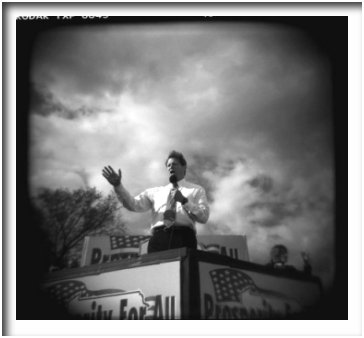Holga, you’ve just started your little affair with this delightful black box! You don’t even know how to load 120 medium format film, and where is the view finder and how can you estimate the shot? And why on earth should I cover a new camera with scotch tape!?
If these kind of questions are filtering through your head, then this might be of help to you:
WHY A HOLGA?
It’s a toy. Yes! I am a kid. Leave me alone and let me play.
Let the child inside run riot and you’ll never be quite the same again. As a grown man (questionable) I glean a great sense of satisaction from pointing this rediculous lump of plastic at people, who actually, feel less threatened by what can only be viewed as a toy.
However, little do they know that inside lies a professional medium format film which, when used imaginatively, renders what can often be stunning, prize winning, photographic results.. supporting any view that it is the photographer (not that 5000 dollar Hasselblad) that really produces pictures of character and depth: see award winning shot of Gore:
|

|
So what is this character of the Holga?
- The plastic lens and infamous light leaks produce vignettes; strangely etheral, retro pictures.
- Medium format negatives, considerably larger than 35mm ones, store professional standard saturated images
- It’s the most affordable way to get into medium format photography.
- You can produce square images, which is a real change from the traditional oblong photos of 2×3 or 3×4.
- It’s simplicity allows you to concentrate on composition rather than pixels. In fact it’s throw away feeling is part of its charm as you find yourself not thinking at all, or thinking so much more before you take a shot.
- It allows you to experiment with multiple exposures effortlessly
- It’s light, surprisingly sturdy, and you don’t worry too much about losing it at $30, so you can take it everywhere and generally abuse it as much as you like.
- It’s so inexpensive and so easily replaced, you can modify, tinker and poke the thing without much worry.
- film schools have even adopted the camera for students
- it’s a conversation starter
I use a HOLGA 120 CFN which is a revamped model with built in flash and 3 colour gells (woohooo) and two speeds ‘N’ for day shots ‘B’ for long exposure shots at night for example.
Preparing Your Holga For The First Shoot
Get some tape an scissors before you do anything. Trust me, you’re going to grow in character and get some very rewarding photographs… just be patient..
The tape is to stop the light leaks in your camera. The camera will let light in so you need to run black tape along the borders of the camera back once you’ve loaded the film. Gaffer tape is very good but can leave alot of residue behind so go with a black electricians tape – it’s clean and unobtrusive. Alot of Holga users thrive on the like leaks so you can decide what you want – loads of light, less light and if you want as little as possible, I’d actually paint the camera inside with a matt black paint as this reduces light flare dramatically.
FILM
The Holga takes 120 ‘medium format’
Your Holga comes with a plastic mask that produces a vertical rectangle format: 16 photos per roll, 4.5cm x 6cm (also known as “456” format). The mask is removable. If you would like to produce 6 x 6, remove the cap – pull and it will come off.
Assuming that you stick with this format for your first roll. Each roll of 120 is spooled onto a plastic spindle; your Holga comes with an empty take-up spindle that is on the right-hand when you open the back of the Holga. Load the film in subdued lighting as low as possible.
Tear the plastic wrapper protecting the film, break the paper seal (ring) holding the roll. To load your camera, you need to notch the beginning of the film roll into the empty spindle, insert the film spool in the left-hand compartment. Wind the film about half a turn and close the back.
Start cranking the winder:
you will see
-
some arrows appear in the red window first
-
keep cranking gently
-
some dots may appear on certain films
-
keep cranking
-
the dots/arrows are guides
-
keep cranking
-
when you see #1 stop cranking
-
you are in your first frame for shooting
-
all preceding frames will be numbered
-
shoot
-
crank to next number you can see in the red frame
Which is the best film?
Highly debatable!
I would recommend ISO 400 for all round use but the nature of your Holga will pretty much decide the best results no matter what you put in there, so experiment.
So, you are now ready to shoot:
-
take the lense cap off
-
seal the sides with tape
-
hit the streets
You will, sooner or later, leave the lense cap on (I did) and while you get used to working with the Holga you might like to get into the habit of alway winding on after you shoot. Make yourself do this to avoid wondering if you’wound on’ or not. You can multi expose on one frame, so again, unless that was your plan – train yourself to wind on after each shot… you’re in the real world now and there is know clever digital chip thinking for you.
The focusing is simple (a guide if you like)
1. the first image is for close work 3 ft
2. the family for 6ft
3. the goup for 9 ft
4. the mountains for infinity
check out www.holgamods.com for advice on changing your specs on the Holga and more information on the camera.


Leave a comment